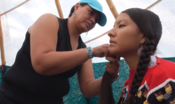Have you ever been the only (fill in category) person in the room? Race, class, gender, age, body type, marital status—any number of identifiers can place us outside the norm, depending on the room. Otherness is a specific experience, especially for those who don’t live it every day. A couple of my students unwittingly placed themselves squarely into the role of “other” in an assignment outside our classroom, and I suspect learned a more powerful lesson than I ever could have taught them in class. The assignment was to find, attend and write an article covering an event. When two students proposed attending a senior citizen fundraising fashion show on the other side of town, I immediately approved the idea.
